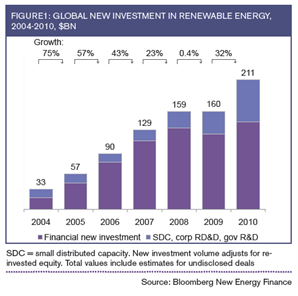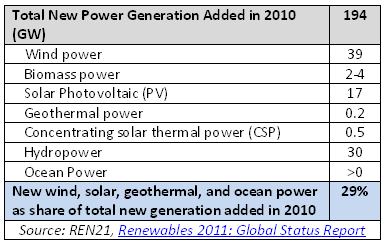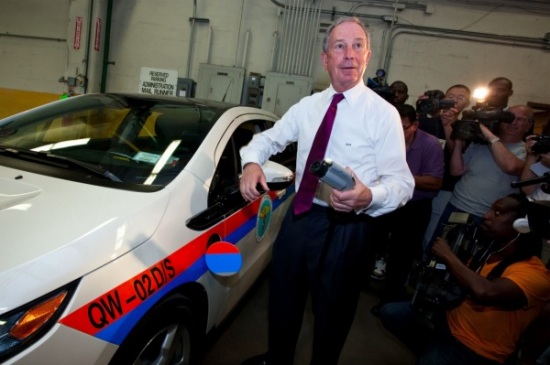Several new reports released over the past few days show that renewable energy keeps growing, with more countries implementing policies or incentives to spur renewable energy deployment. The studies found that renewable energy accounted for $211 billion in new investments in 2010 – an increase of 32% from the previous year. Next year at the Earth Summit in Rio, countries and companies have a chance to build upon this momentum by committing to deeper actions to spur renewable energy deployment within their country and company. This is an important opportunity that shouldn’t be missed.
So what are the key findings of these new reports (one from the Renewable Energy Policy Network for the 21st Century –REN21—and the other from the UN Environment Program –UNEP)?
Renewable investments are a very large sector that is growing rapidly. If it were a country, the total value of new renewable energy investments in 2010 would make i t the 42nd largest economy in the world.* According to Bloomberg New Energy Finance data, total new investments in renewable energy amounted to $211 billion in 2010 – a 32% increase from the previous year. The value of renewable investments has been growing significantly from 2004 when data was first collected (see figure). New renewable investments have achieved a staggering 539% increase since 2004. That increase would compare very favorably to any economic sector in the world.
t the 42nd largest economy in the world.* According to Bloomberg New Energy Finance data, total new investments in renewable energy amounted to $211 billion in 2010 – a 32% increase from the previous year. The value of renewable investments has been growing significantly from 2004 when data was first collected (see figure). New renewable investments have achieved a staggering 539% increase since 2004. That increase would compare very favorably to any economic sector in the world.
More countries are taking action at home to spur renewable energy deployment. At least 119 countries had some type of national policy target or renewable support policy. The number of countries with such policies more than doubled since 2005. As a result, commercial wind power exists in 83 countries – whereas just a handful had wind in the 1990s. In 2010, solar PV capacity was added in more than 100 countries. This shows that wind, solar, and other renewable energy sources aren’t some mythical source of energy that only a small number of countries can tap into.
Non-fossil energy* accounted for almost 50% of the new electricity capacity added in 2010. Wind, solar, and geothermal accounted for about 30% of the estimated new electricity capacity brought on line in 2010. If you include hydropower and biomass power then the share of non-fossil fuel power capacity was around 50% of the total new installed capacity in 2010 (see table). While sources of electricity that contribute to global warming are still too large, this data shows that more countries are investing in renewable energy as they look to meet their growing energy needs.
installed capacity in 2010 (see table). While sources of electricity that contribute to global warming are still too large, this data shows that more countries are investing in renewable energy as they look to meet their growing energy needs.
Major growth is occurring in the developing world, especially China and India. In 2010, developing countries overtook developed countries in terms of new financial investments in renewable energy (see figure). China led the pack with $49 billion in new investments – a 28% increase from the previous year. The U.S. was second with $25 billion. Major developing countries have seen significant annual growth rates for the period 2004-2010: Brazil (62%), China (80%), India (19%), and Africa region (51%).  Similar trends are seen for important renewable technologies. In 2010, China installed the most wind and solar thermal energy of any country. India is currently fifth worldwide in total installed wind capacity. In fact, 5 of the 10 largest wind turbine manufacturers in the world were companies founded in China and India. Similarly, 9 out of the top 15 solar PV manufacturers were either from China or Taiwan (see REN21).
Similar trends are seen for important renewable technologies. In 2010, China installed the most wind and solar thermal energy of any country. India is currently fifth worldwide in total installed wind capacity. In fact, 5 of the 10 largest wind turbine manufacturers in the world were companies founded in China and India. Similarly, 9 out of the top 15 solar PV manufacturers were either from China or Taiwan (see REN21).
Earth Summit in Rio next year provides a huge opportunity for countries and companies to go even further in speeding up the deployment of renewable energy. As world leader, CEOs, governors, and mayors show up in Rio de Janeiro, Brazil next year for the Earth Summit they’ll need to come prepared to show how they are going to take the next step. What kinds of new policies will they implement to help renewable energy? What new steps will the company take to help spur this development? Will they make new commitments to increase renewable energy deployment?
We hope that they take advantage of this opportunity and build upon this increasing renewable energy deployment. This staggering growth should only be the beginning of a move to clean renewable energy in meeting the world’s energy needs.
———
* New renewable energy investments are just behind the GDP of Israel and are larger than the GDP of Ireland, Chile, the Philippines (see World Bank GDP data).
** Note REN21 lists these as “renewable energy” in their totals. The total presented her doesn’t include nuclear, which is another “non-fossil fuel” power generation source. Also note the UNEP report has different figures for some of these totals.


